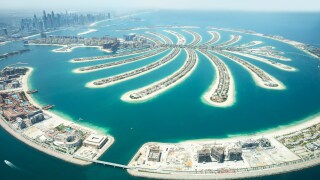The overarching theme of the conference? Maximising on the opportunities Marseille presents – and, of course, looking at where the next European hub is going to be.
Byron Clatterbuck, CEO of Seacom, was on the keynote panel at this year’s conference: “Marseille is the gateway into Europe,” he said. “More and more we see people go through Marseille to connect to the internet cloud.”
Fellow panellist Andrew McGrath, SVP of connectivity at Vodafone Carrier Services, said that, while Marseille is a crucial hub from Vodafone’s perspective, “we enjoy competition”. He added: “Diversity and other options are important to us as well.”
Apostolos Kakkos, chairman and CEO of Lamda Hellix, thinks that Interxion is directly to thank for turning Marseille into a hub – not just by creating the ideal conditions but by correctly timing its arrival into the world of carrier-neutral data centres. “Lamda Hellix has invested heavily in creating a number of similar ecosystems in Greece,” he said.
It was during a panel on interconnection-rich data centres that Ivo Ivanov, CEO of DE-CIX, offered his opinion on what determines a key interconnection point from the perspective of an internet exchange.
It depends on “the existence of a proper regulatory framework, ideally an open one without a lot of restrictions”, he explained. It also needs “business and political stability in the region, and a properly developed data centre structure, ideally combined with an internet exchange platform”.
But Giuseppe Sini, head of international business at Retelit, said it was less clear-cut than that, pointing out the “chicken-and-egg problem” that exists when choosing the next interconnection location.
“Why do you go to certain locations? Because there are some factors that make it right for landing a subsea cable, but for the environment to be there, it should have the subsea cable already,” he said.
However, Giuseppe Valentino, Sparkle’s vice president for the IP and data line of business, was keen to differentiate between the different types of interconnection environments and the needs for both.
“There’s a difference between a cable landing station environment and an edge data centre environment. To me the landing station environment is a geographic location that connects with the submarine cable infrastructure – and then it goes somewhere else because there is no real ecosystem developed,” he said.
“The ecosystem within those facilities grow and allow interconnection there, not somewhere else,” he added. “Interconnection in today’s telecom market means direct access to other networks, applications, platforms and content.”
The ever-changing concept of the subsea cable consortia was also a big talking point throughout the event. The opinion was that consortium cables are not dying out – but the definition and make up of them has changed.
“I think the question is, what are consortia today?” asked Paul Vasilopoulos, partner at DH Capital. “Before, you’d see the carriers like AT&T, Verizon and BT coming together – and today you still see that but you also have a number of OTTs in the mix. So how do you manage that?” The nature of consortia has changed,” he said. “It’s evolving with the OTTs. That’s what we’re seeing.”
His thoughts were echoed by Santhosh Rao, head of telecommunications for the Americas at the investment bank Natixis. He said the model has evolved and OTTs are no longer customers but owners.
“The roles of the various players are evolving,” he said. “Telcos are going from owners of the underlying infrastructure to renters of the network, while OTTs are becoming more of the demand driver within the subsea cable space and they’re looking for ownership economics.”
Ivanov was asked about the advantages of connecting directly into the data centre. “That’s an interesting question because I do not see any disadvantages, provided there is a proper environment there. And provided the cross-connect in the data centre from the sea cable landing demarcation point is a reasonable one.”
He said there are mistakes from the past that shouldn’t be repeated – such as high pricing, so called “golden cross-connect” charges, not having existing content on-site and very pure regulation in the region.
New data suggests that there is a southward trend in data traffic coming from Africa, Asia and the Middle East interconnected with Europe and South America. Ivanov said the best way to tackle this is “through sea cable connectivity landed properly in data centres with well-maintained internet exchanges and interconnection platforms”.






